[Author: Paul D’Andrea, Owner & Founder of Sierra Sports & Tours)
Here you can find my favourite mountain packed European road cycling loop rides. The distance of these Top 10 road bike rides typically range between 50-100km, 1500-3000 metres of elevation gain and include 2 to 4 categorised climbs. The order selected is not based on difficulty but the pure pleasure of cycling in the mountains with incredible landscapes and brilliant climbs. Quiet roads also earn some of the routes some extra bonus points. To add some suspense the loop rides are counted down from number 10 to 1.
At the conclusion of this blog I also put the spotlight on three European road cycling loops that I still need to ride and which are at the top of my post Covid cycling bucket-list. There are many European countries still to explore so if you have a favourite road cycling loop ride in Europe please feel free to share it here!
10. Bellagio loop ride (Lake Como, Italy)
Ride Stats: 55km / 1400m elevation gain
This 55km ride packs some real heat with the ´Ghisallo´ and ‘Sormano’ climbs straight from the Giro di Lombardia professional race. The Giro di Lombardia is the 5th cycling monument race alongside Milan-San Remo, Tour of Flanders, Paris Roubaix and Liege-Bastogne-Liege. Bellagio is considered to be the pearl of Lake Como and for cyclists it is a wonderful experience arriving at Piazzale del Ghisallo at the climb summit with the church dedicated to cyclists and the new cycling museum!
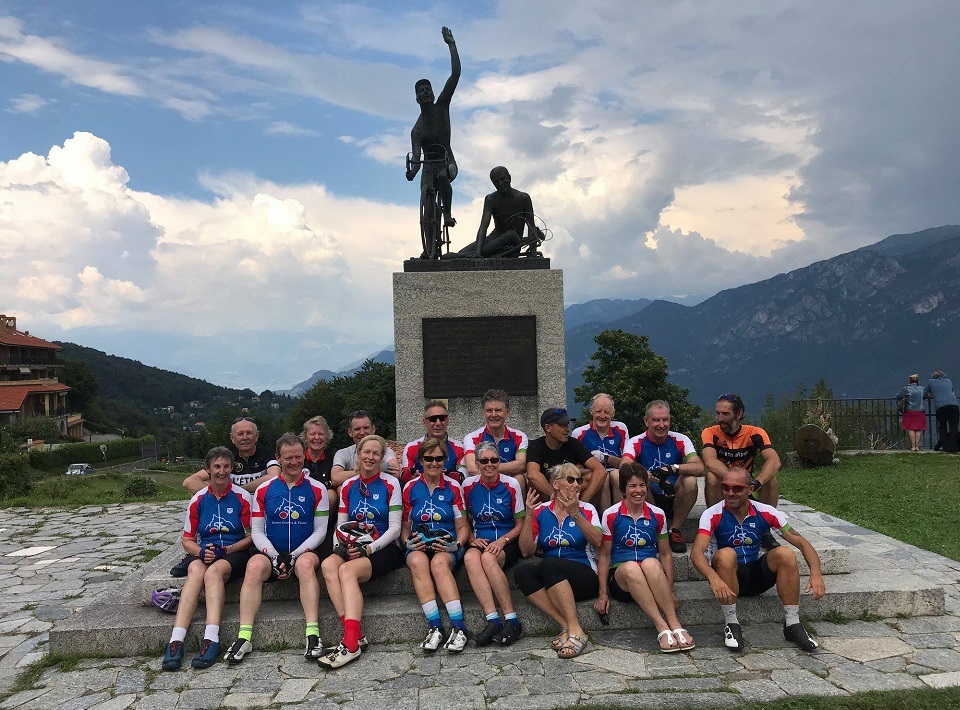
Following an enjoyable descent from the Madonna del Ghisallo some kilometres after the Barni township one veers off to the right in search of Muro di Sormano which is an authentic wall. Time to push yourself over this short but painfully steep climb. The climb is 1.7km long but with an average gradient of 17% and ramps pressing 24% it’s one of the toughest challenges around! The climb first featured in racing circles during three consecutive editions of the Giro di Lombardia during the early 1960’s. Many riders though were forced to walk or pushed up by cycling fans and in 1963 it quickly disappeared from the pro scene. In 2006 ‘il Muro’ returned to local racing and by 2012 the Giro di Lombardia was back writing ‘Sormano’ into cycling folklore!
We select Bellagio on Lake Como as our final stay during our Epic Italian Alps cycling tour. What better place to visit and relax after finishing up on the nearby Stelvio Pass!
9. La Rioja loop ride (Spain)
Ride Stats: 60km / 1300m elevation gain
This loop ride begins in the medieval walled town of Laguardia. The initial 15km are spectacular following the undulating terrain through the terraced vineyards of La Rioja. A glass of tempranillo wine anyone? The first pass to contend with is the ‘Alto de Rivas’ climb which separates La Rioja region from Basque Country. This climb takes you up into dense woodlands and it is not surprising that it is a major feature of the Orbea Vitoria Gran Fondo ride held every May. The descent through the woods is fast and furious and pure Basque road cycling style!
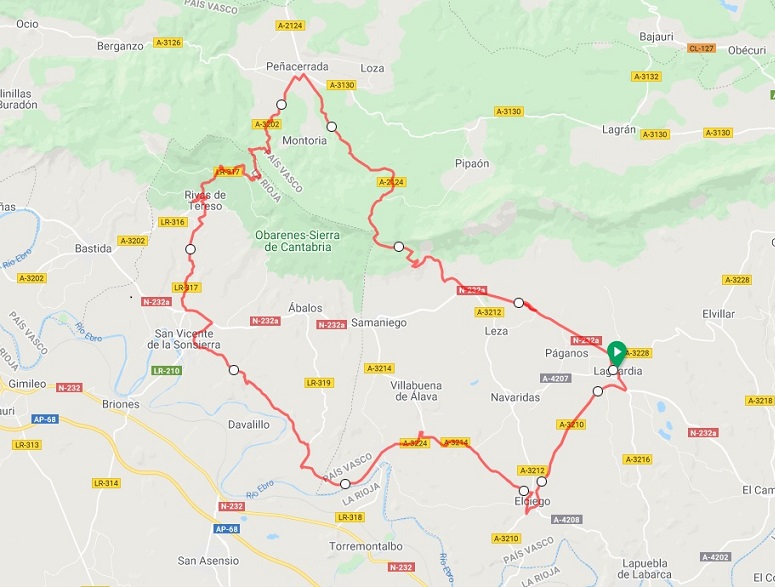
It is not an overly long loop ride at 60km (1300m elevation gain) but the final climb Puerto de la Herrera packs a good punch when ridden from the north side. Herrera is a regular feature in the professional stage race Vuelta a Basque Country. It is a 7.5km climb through thick forest and it’s 5% average grade hides several short 10-12% grade ramps. Once at the top you are close to what is called the Balcony of La Rioja and the views down to the award-winning Spanish wine region are well and truly worth a photo stop. The descent down to ‘winery-ville’ needs to be respected as there are some long straight sections where considerable speed is won before some mid-col switchbacks which are very tight and technical. Take care!
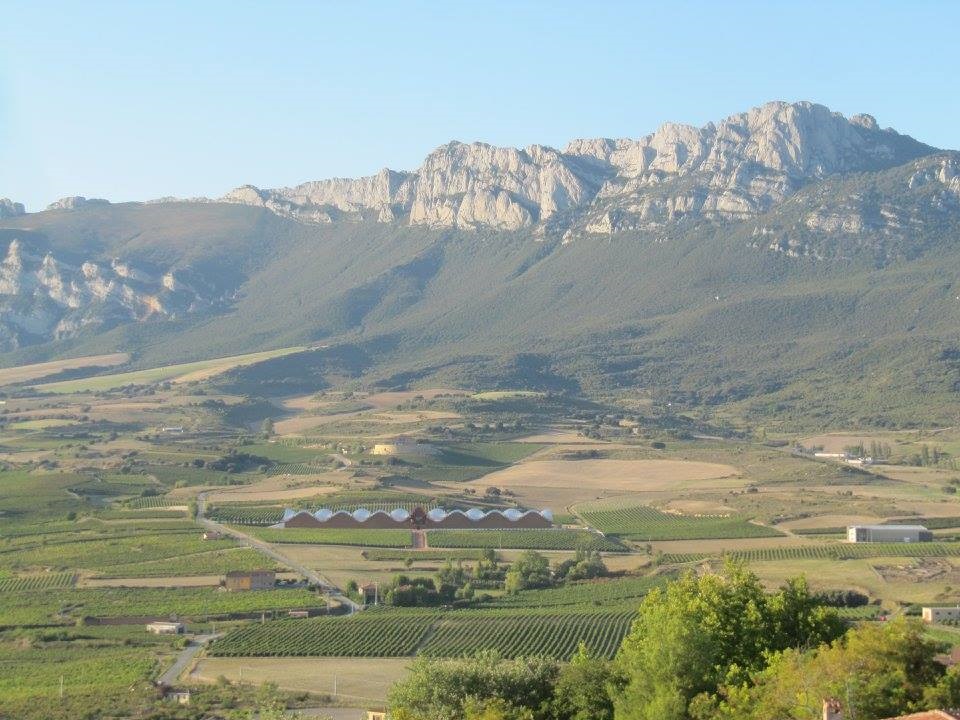
The region is regularly included in La Vuelta (Tour of Spain) professional cycling race and here you can find a link to some of our photos from La Rioja and surrounds. Over the years we have also regularly stopped off in La Rioja when driving from Madrid to the Spanish Pyrenees.
8. Cazorla National Park loop ride (Andalusia, Spain)
Ride Stats: 95km / 2200m elevation gain
Cazorla National Park is the ideal playground for those who love road cycling. It is pretty much unknown to international travellers who typically head straight to the southern Spain beaches. This is a special loop as it includes initial climbs which are short and sharp and which pass through rocky ‘Grand Canyon-esque’ terrain. The Ceal and Hinojares walls were used during the 2017 Vuelta a España professional cycling road race.
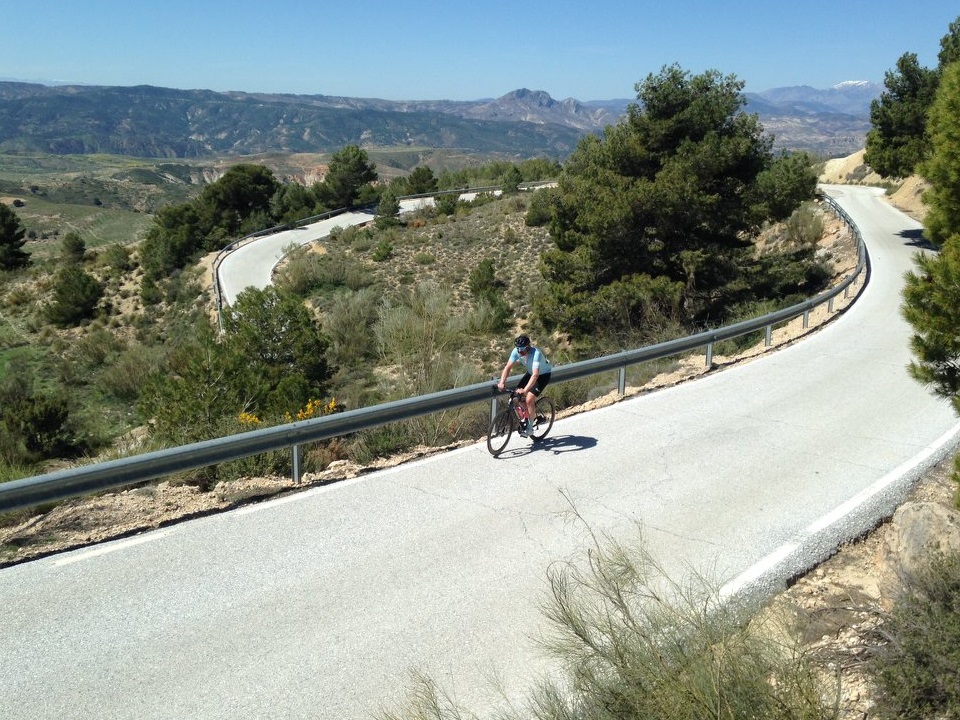
The scenic climb in this gem is the Puerto de Tiscar climb. ´Tiscar´ is a Category 2 climb (8km with a constant 6% grade) and offers amazing views of the surrounding valleys and peaks! One of the best descents we have ever experienced is the flowing ride down to Quesada. Overall this 80km loop provides access to the rocky landscape of the south western corner of the Cazorla National Park which is part of Spain’s largest national park.
The Cazorla National Park is only a 30 minute drive from ‘Renaissance Spain´ (Baeza and Ubeda townships in Andalusia). Every year we love rolling out our private group Renaissance Spain cycling tours which combine the best of Cazorla, Baeza and Ubeda.
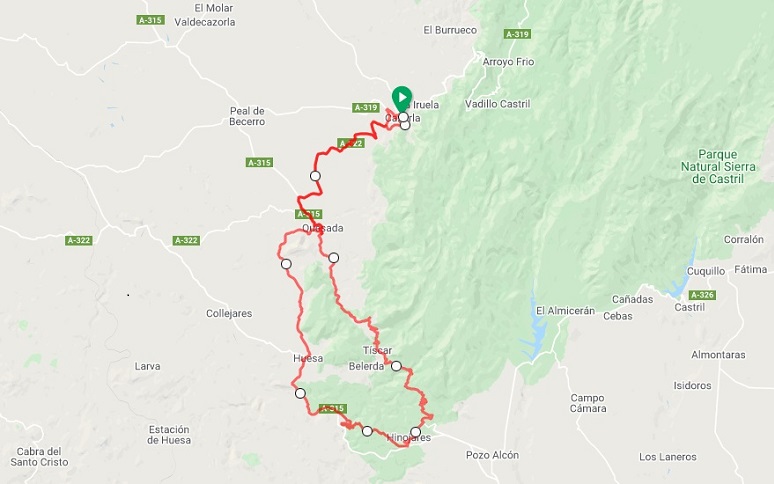
7. Alpe d’Huez loop ride (Rhone Alpes, France)
Ride Stats: 80km / 3000m elevation gain
This loop ride can be shortened and/or done in reverse but to get the most out of a big day on the bike we like the option presented herein as one also finishes things off with the climb to the top of the 21 bends! Starting in the Alpe d’Huez ski village the ride begins with a 10km warm-up on back roads to the summit of Col de la Sarenne at 1999m. The following 15km descent must be respected as the road is narrow and steep but this is not a race so it should be fine. Caution first and foremost plus you also need time to admire the beautiful Ferrand valley.
Once down in the Oisans valley floor turn right and continue towards Le Bourg d’Oisans. Now the climb to to Villard Reymond will be sure to impress. The climb rises out of Le Bourg d’Oisans and while it is asphalted for the most part it also includes a few unsealed sections for the gravel grinders. The views across the valley to the Alpe d’Huez ski station are exceptional and will give you goosebumps for what is next on the agenda.
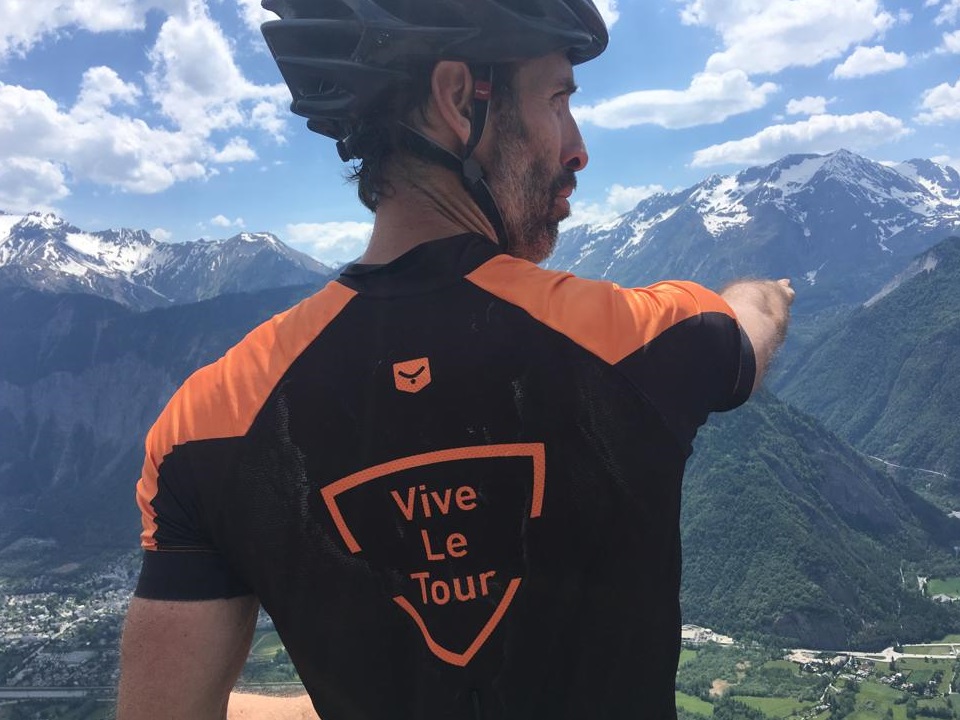
Following a great descent towards Ornon you will be back near the base of Alpe d´Huez and its famed 21 switchbacks (lacets in French and depicted in our exclusive Sierra jersey below). No other mountain has had so much Tour de France drama. With or without the TDF the atmosphere on the mountain is always fantastic and the 13km at 8% average grade will be a constant test. Each of the 21 hairpin bends has been named after past stage winners.
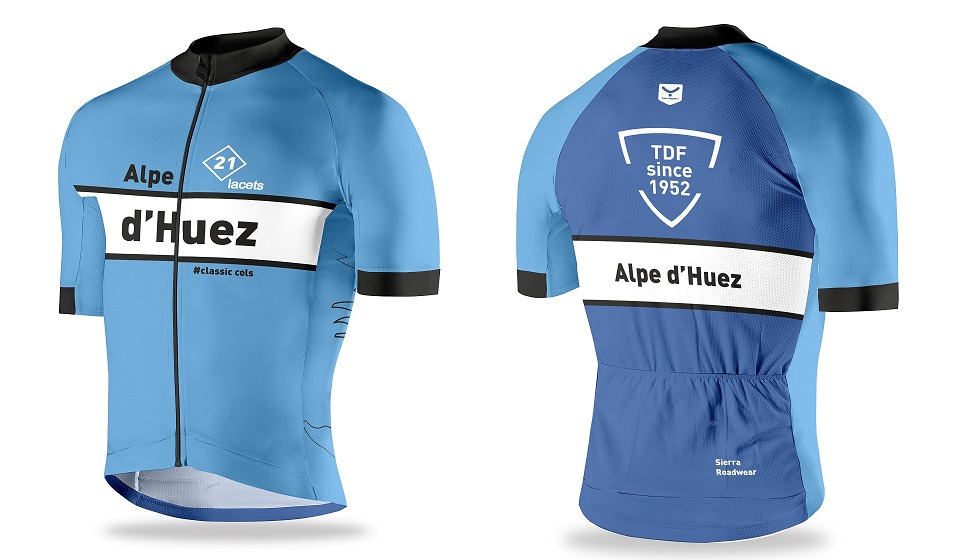
Alpe d´Huez has hosted 30 Tour de France stage finishes making it centre stage for many famous battles. Going back to 1952 and Fausto Coppi won the first ever summit finish attacking with 6km to the summit. Alpe d’Huez is a household name amongst cyclists and non-cyclists alike. Now you can say you have also ridden up it!
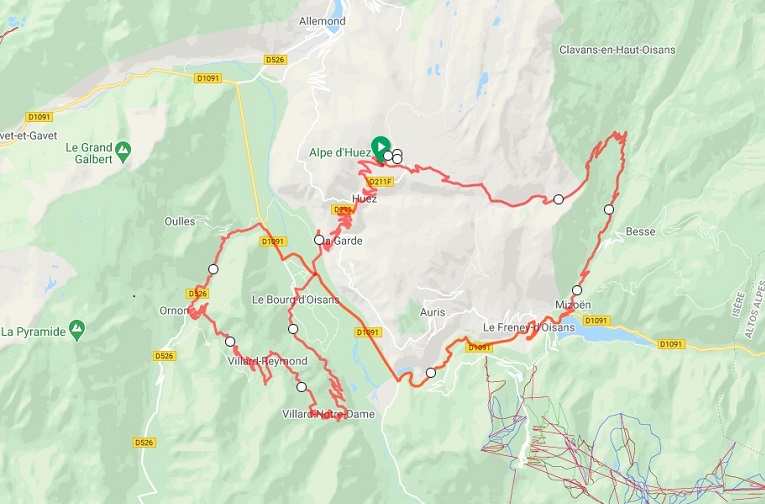
If you would like to learn more please take a read of our detailed ‘Cycling in the French Alps’ web cycling guide.
At the same time, if you would like to ride the French Alps in the future here you can find a link to our Epic Alps cycling tour itinerary which is bookended by Alpe d’Huez and Mont Ventoux.
6. Sierra Nevada loop ride (Andalusia, Spain)
Ride Stats: 60km / 1750m elevation gain to Pradollano ski station or continue up to Pico de Veleta and 85km / 2550m elevation gain
Granada sits directly below the towering Sierra Nevada mountains in southern Spain. The highest peak is 3400m elevation and Pico de Veleta at approximately 3300m is the highest asphalted road in Europe. Now that is more than 500m higher than Col de l’Iseran or Stelvio Pass which is saying something! From Granada which rests at approximately 765m elevation there are 6 ascents of varying difficulty up to the Sierra Nevada ski village (Pradollano at 2390m elevation). All are perfect for road cycling and our loop ride selection here is based on La Vuelta a España and La Vuelta a Andalucia race history, quiet roads and scenic long descents.
Heading out of Granada the cycling goes in search of Guejar Sierra. There is no other word for it but the Haza Llana climb, which measures 7km and at 9.5% average grade, is a straight-out wall. With no less than 10 short ramps all between 15-20% in the first 4.5km it is a serious test. Collado de las Sabinas is up next and it climbs for 8km (6.5% average grade) and takes you to the Pradollano ski station.
Many decide to turn around here and head back to Granada but for the altitude junkies out there why not push on up to the military barrier and ride without traffic for a further 12km up to the ‘Pico de Veleta´ summit. Roll back down to the ski station and enjoy a further fast 25km descent down the main road which includes a turn off to Pinos Genil and back into Granada.
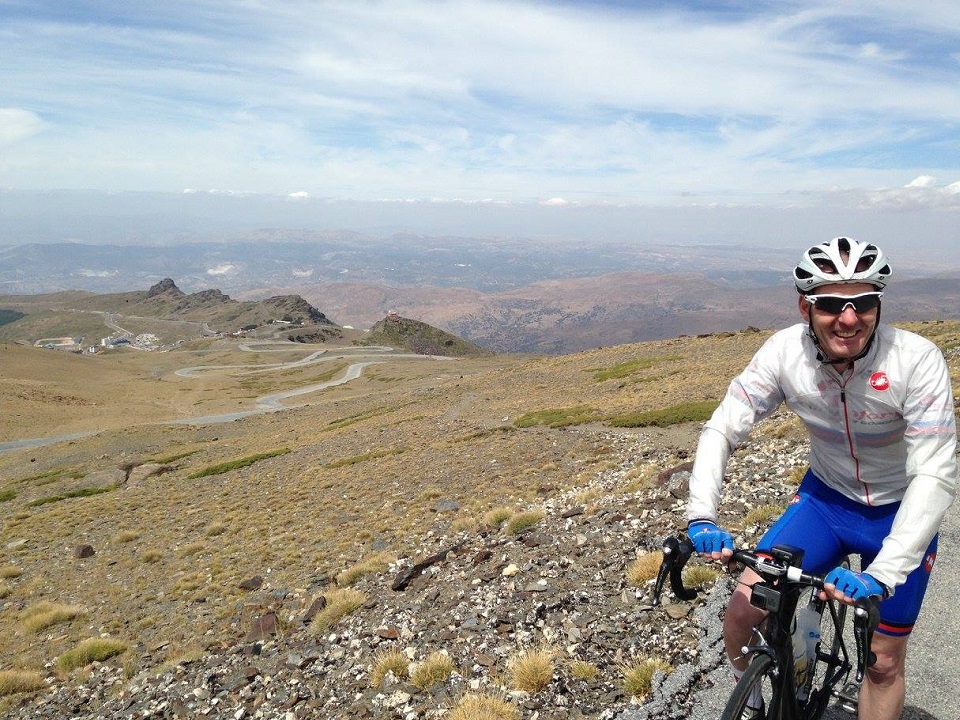
Cadel Evans during his years with Team Silence-Lotto used Sierra Nevada in Andalusia as his altitude training base on multiple occasions and these mountains were considered the secret weapon for a number of his TDF campaigns. Go riding during May and June and you will typically find riders from Cofidis, Quickstep and Movistar to name just a few professional cycling teams training for the Tour de France. It has been quite a buzz riding alongside riders of the calibre of Philippe Gilbert, Bob Jungels and Alejandro Valverde over the years.
To find out more about Pico de Veleta and cycling in the Sierra Nevada mountains you can also follow our in depth blog article titled ‘Cycling Europe’s Highest Asphalted Road’.
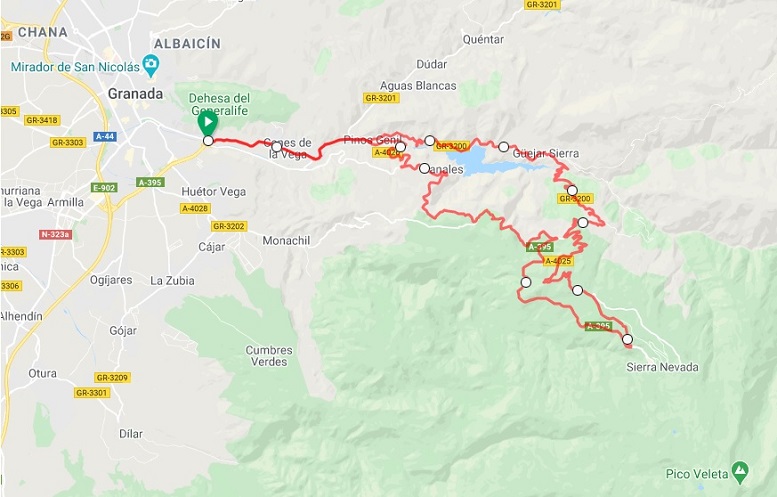
5. Stelvio Pass & Umbrail Pass (Italy & Switzerland)
Ride Stats: 105km / 3600m elevation gain
From Bormio the road climbs up for 19km within Italy before reaching the Italian/Swiss border. Here you intersect the Umbrail Pass summit at 2501m elevation and officially Switzerland´s highest mountain pass. A spectacular 20km of Swiss road cycling awaits which is predominantly an epic descent all the way down to the Val Mustair valley. This is a big loop ride at 105km and 3600m elevation gain so Glorenza is a quaint town and perfect stop to recharge for what lies ahead.
After shortly thereafter exiting the Prato Allo Stelvio township you will be ready to climb the mythical Stelvio north side with its 48 hairpin bends that rise up and up for 25km and which gain 1840 metres of elevation. Passo Stelvio (2758m) is the highest asphalted mountain pass in the Eastern Alpes, second only to Col de l’Iseran (2770m) in the French Alpes in elevation and with more than twice the number of switchbacks as the famous Alpe d’Huez.
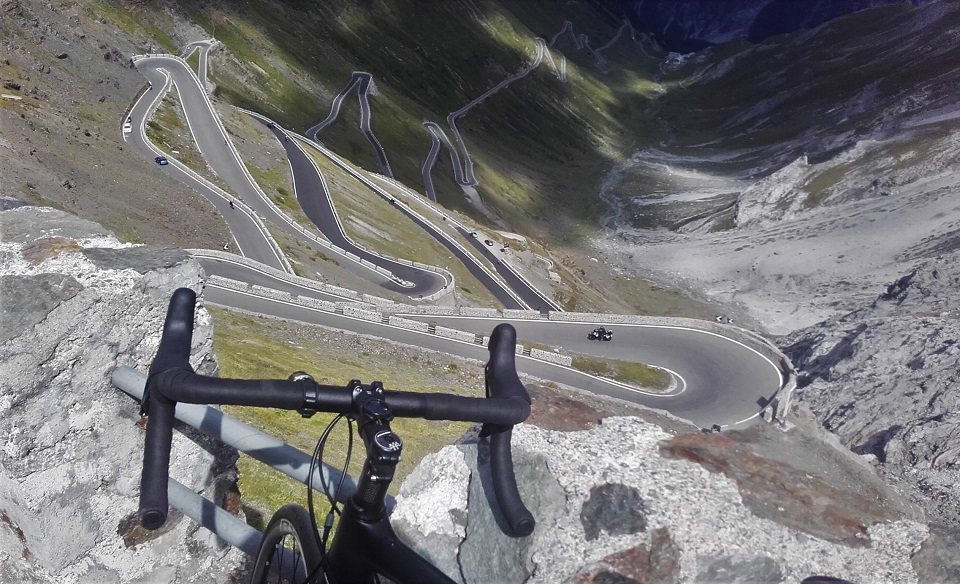
When it comes to Giro d’Italia history the Stelvio Pass has been contested on 12 occasions. It first appeared in 1953 when during the penultimate stage the Italian legend Fausto Coppi attacked on the Stelvio Pass to take the lead and secure victory in Bormio as noted on our exclusive Stelvio cycling jersey. The north side of the Stelvio is the iconic, legendary climb from the Giro d’Italia. 7 of its 12 passings have been held during either Stage 20 or 21 highlighting its importance. Make sure to have a jacket ready for the first part of the descent back down to Bormio as it is almost always cool on top.
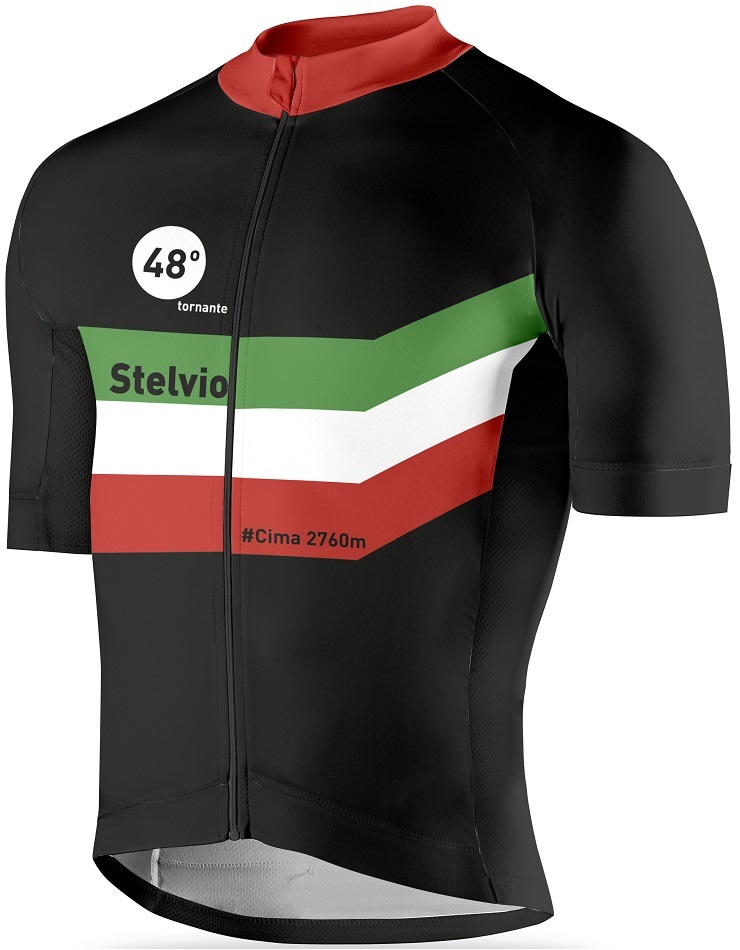
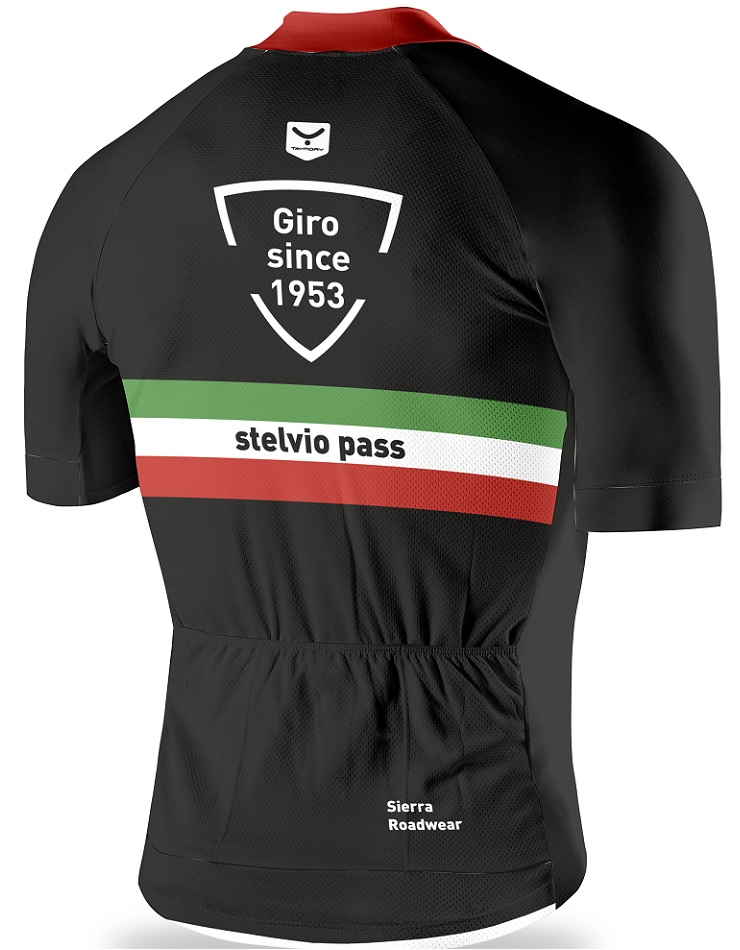
To find out more in-depth analysis of ‘Cycling the Italian Alps’ please visit our comprehensive blog feature article!
Furthermore, if you would like to ride the Stelvio National Park in the future here you can find a link to our Epic Italian Alps cycling tour itinerary which is a Venice to Milan journey that also includes the Dolomites and Lake Como.
4. Sella Ronda loop ride (Dolomites, Italy)
Ride Stats: 55km / 1850m elevation gain
The Sella Ronda loop is one of the world´s most iconic cycling routes and is a must for any cyclist who visits the towering Dolomites mountain region. There are 4 steps to become a member of the Sella Ronda club: Passo Pordoi, Passo Sella, Passo Gardena and Passo Campolongo. The views of the jagged limestone peaks, pine forests, alpine meadows and winding roads will be etched into your memory for a lifetime!
Here is a summary of what it takes to join the Sella Ronda club and earn the rights to our exclusive Dolomites cycling jersey:
- Passo Pordoi: 9.2 km, Average Gradient: 6.9%
- Passo Sella: 5.5 km, Average Gradient: 7.9%
- Passo Gardena: 5.8 km, Average Gradient: 4.3%
- Passo Campolongo: 5.8 km, Average Gradient: 6.1%
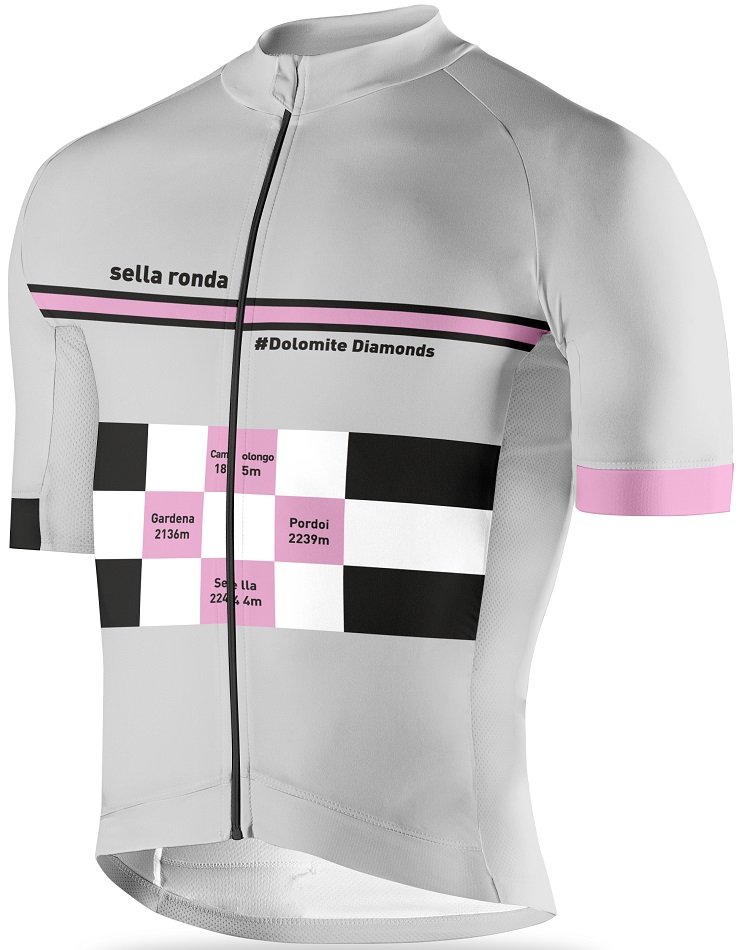
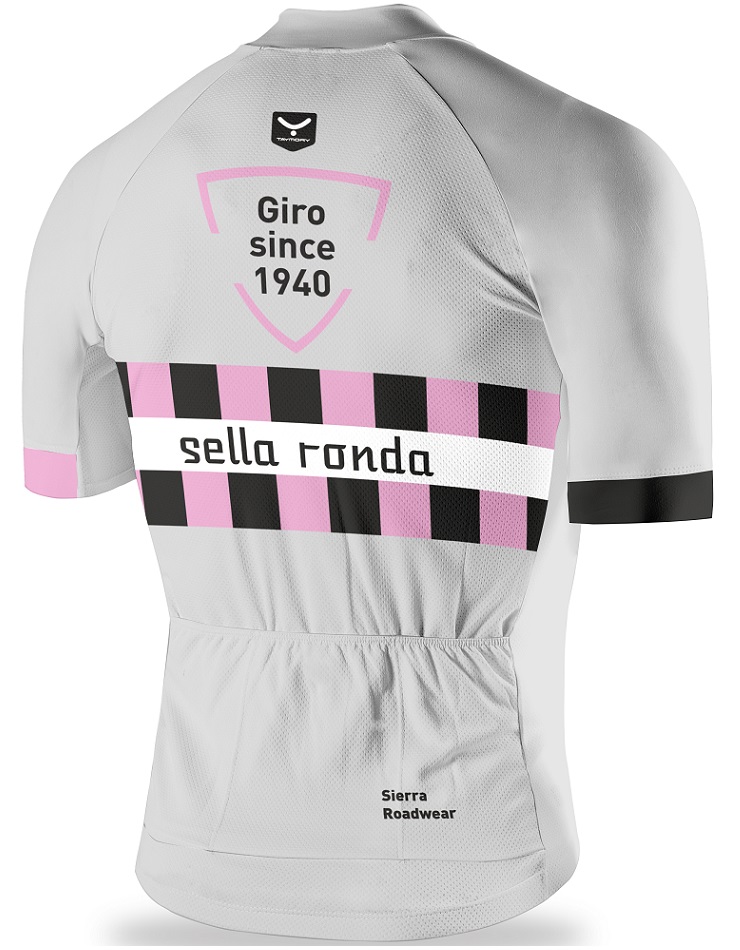
Don’t let the relatively low kilometre count trick you as each pass goes accumulating elevation. The total loop only measures 55km but there is almost 1850m of elevation gain! The Sella Ronda is the core of the ‘Maratona dles Dolomites’ gran fondo cycling event. 9000 riders line up every year to tackle the Maratona which is described by National Geographic as “one of the biggest, most passionate, and most chaotic bike races on Earth”. Riding around the Sella Massif is about as good as it gets for mountain scenery! Just take care with the busy traffic during summer.
The Dolomites are also home to many other famous Giro d’Italia climbs (Passo Giau, Passo Fedaia, Tre Cime di Lavaredo) and which are presented in our ‘Cycling the Italian Alps’ blog. Also, click here for some Sella Ronda cycling photos !
3. Irati Forest loop ride (Navarra & Aragon, Spanish Pyrenees)
Ride Stats: 55km / 1350m elevation gain or continue up to Piedra de San Martin and collect 100km / 2450m elevation gain
The Irati Forest is one of Spain´s best kept road cycling secrets. Wild mountains, gorges, fast flowing rivers and lush farmland provide the perfect backdrop for road cycling. Setting off from Isaba and the early kilometres pass through the pristine Roncal Valley. The first 5km climb at 6.5% average grade moves eastwards from Navarra province up to the border with Aragon. A technical descent follows on slightly coarser/irregular asphalt and which forces you to slow down a little and have time to admire the spectacular views.
Once down in Anso village take a coffee break and explore its small cobbled lanes before a gradual drag against the flow of the Veral River (16km at 3% average grade). It is this section of the route that in several sections resembles the Italian Dolomites for scenery. The loop back to Isaba brings the ride to a total of 55km and 1350m elevation gain.
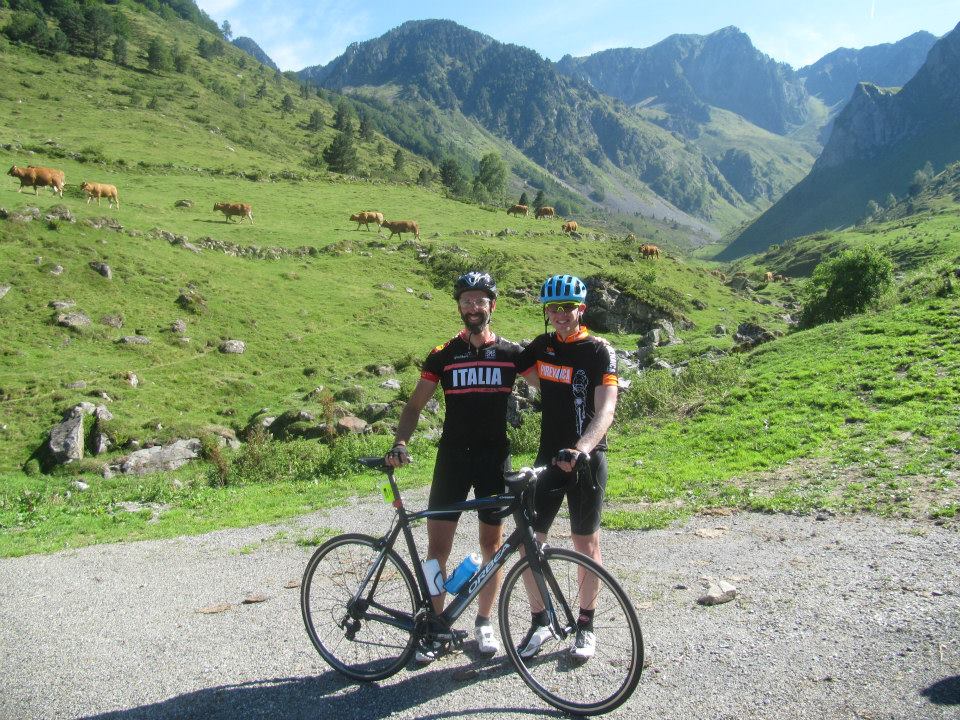
If you are looking for a challenge then only 3km before Isaba you will intersect the N137 road. Turn left to head back to Isaba and complete the 55km ride or turn right towards France and take on an optional 16.5km climb called ‘Piedra de San Martin’. This is the same mountain pass where Chris Froome won the Stage 10 summit finish during the 2015 Tour de France (only difference being you will reach this peak from the Spanish and not French side)! This brilliant climb takes you up to the Spanish/French border and it is a constant 6-8% grade climb all the way to the top. Now all that remains is a wonderful descent back into Spain and the Irati Forest bringing the full ride to 100km and 2450m elevation gain.
The Irati Forest we call home for our final cycling destination during our Pyrenees Coast 2 Coast cycling tour. Take at a look at our itinerary if cycling over the Spanish and French Pyrenees is on your radar.
Spain’s five time Tour de France champion Miguel Indurain is also a local to the region and here you can have a read of our travel blog story where our Sierra guests back in 2014 were accompanied by Big Mig on a 150km ride through the Spanish Pyrenees!
We are also currently working on an in-depth ‘Cycling the French Pyrenees’ blog which should be available around early 2021. We have written above about the Piedra San Martin climb from Spain but this soon to be released guide will provide details on all of its 7 possible ascents from France!
2. Mont Ventoux loop ride (Provence, France)
Ride Stats: 85km / 2200m elevation gain
When it comes to challenging, beautiful, rewarding and historic pro-cycling routes then this road cycling loop ride has all of the above rolled into one plus more! Cycling through Provence is amazing at the best of times but this adventure through Sault, Gorges de la Nesque and Mont Ventoux is one to savour!
From Bedoin the early kilometres up Ventoux are quite easy cycling past vineyards and following the famous southern route straight from the Tour de France. Here you can still keep an eye on the prize being the iconic summit weather station. On reaching the St Esteve bend you enter the ‘forest’ and things do not let up for nearly 10km. Rejoice on arriving at Chalet Reynard where you can catch your breath. From here the average 8% now feels flat unless you are unlucky to be hit by strong winds on the exposed white cliffs.
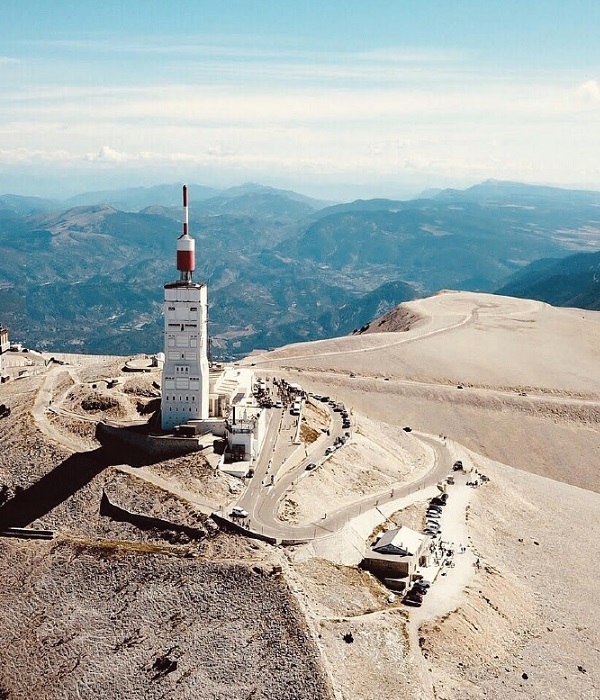
Be amazed as every pedal stroke now reveals the lunar landscape towards the summit! We have created the slogan ‘South Side of the Moon’ for our exclusive Ventoux cycling jersey to commemorate the 10 TDF stage summit finishes on Mont Ventoux and what is the iconic southern ascent from Bedoin.
Here is a glimpse of what to expect on Ventoux from Bedoin:
KM 0 – 6: 4% average grade up to the famous St Esteve bend
KM 6 – 15: the feared forest with constant climbing always touching 9 – 10%
KM 15 – 21.4: the lunar landscape above Chalet Reynard at 8% average grade
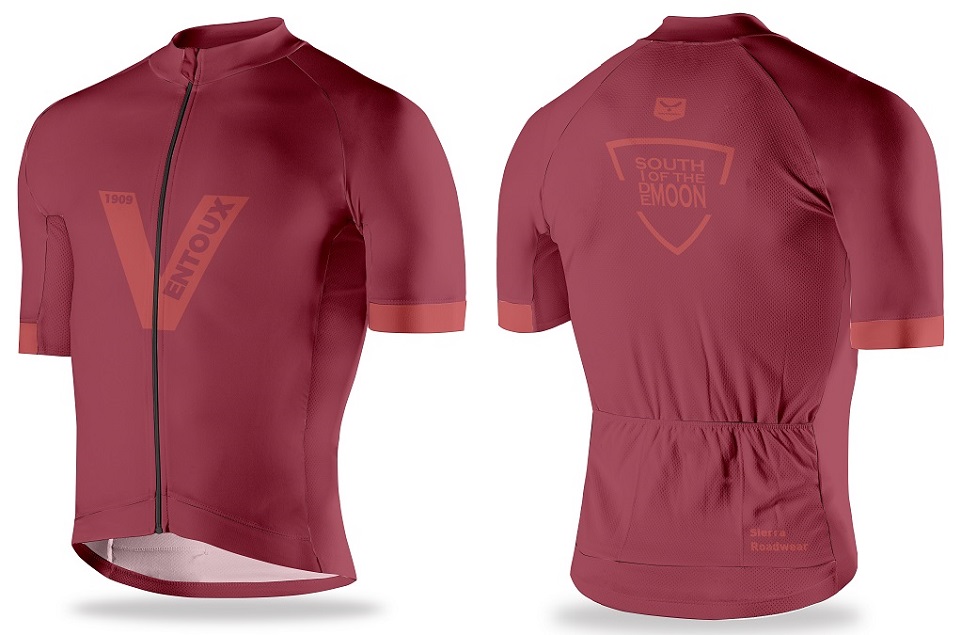
From the summit descend back to Chalet Reynard and take the left turn to Sault. A 26km winding descent which never gets too steep is pure road cycling pleasure. Towards the base you will start to pick up wafts of lavender as you pass through these fields. To cap off a remarkable ride head in search of Gorges de las Nesques. This gorge, which is dramatically cut into the landscape, will lead you back towards Bedoin and the base of Mont Ventoux.
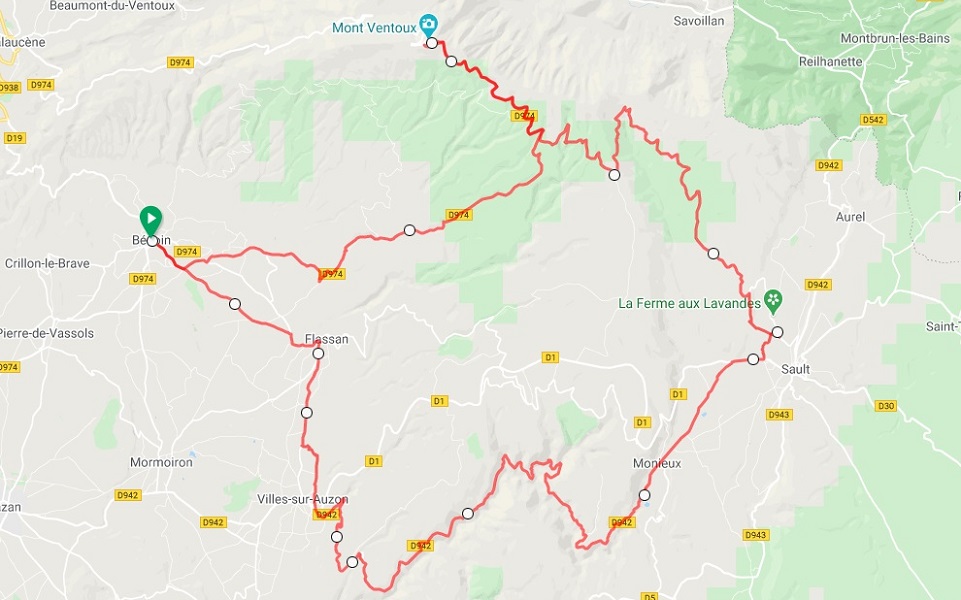
Additional information for cycling around Provence and the French Alps can be found in our ‘Cycling in the French Alps’ online guide. A selection of awesome photos can also be found in this Alps & Mont Ventoux cycling photo gallery.
Mont Ventoux is also the final cycling challenge on our Epic Alps cycling tour if a future ride through France might be of interest.
1. Sierra de Grazalema loop ride (Andalusia, Spain)
Ride Stats: 90km / 2500m elevation gain
The Sierra de Grazalema mountain range is our top Spanish cycling base. Cycling alongside turquoise coloured reservoirs, through white-washed Andalusian villages and up and down quiet mountain roads is something road cyclists normally can only dream of. This mountain loop ride includes the Puerto de las Palomas climb and the Puerto del Boyar climb.
´Palomas´ is a Category 1 climb that has been used 3 times during La Vuelta a España. It is a 14km climb with a constant 6% grade and we would be lying if we said this wasn´t our favourite climb in Andalusia. We typically like to begin from the dam wall where you can just make out the top of the pass. The views from the upper switchbacks down to the reservoir give you the sensation of flying with the local vultures rather than cycling!
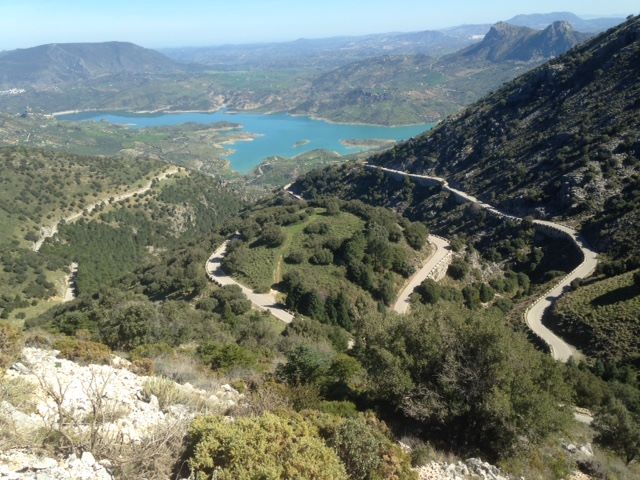
A technical descent down to Grazalema, some time trial kilometres, a further switchback descent and a very lumpy section lead to the base of the final Puerto del Boyar climb. With a lot of work already in the legs the 14km at 5.5% average grade means the Boyar climb should not be underestimated. A truly memorable day on the bike!
For those keen to ride this region the beautiful town of Ronda sits right on the edge of the Sierra de Grazalema. Malaga Airport is only a 1hr 15min drive away. To find out more check out our Costa del Sol (Malaga to Ronda) private cycling tour suggestion.
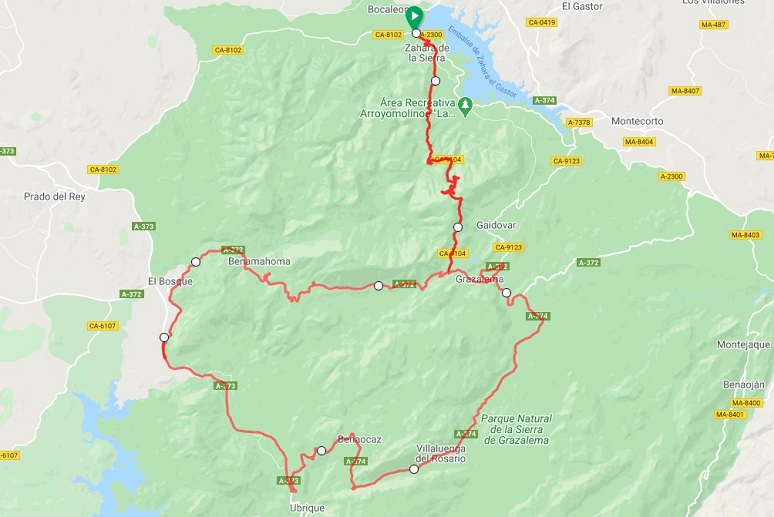
3 Cycling Routes Still on the Radar
1. San Gottardo, Furka Pass & Nufenen Pass (Swiss Alpes)
While members of our Sierra team have lived in Switzerland before I am still dreaming of riding this route in the anti-clockwise direction. From Airolo the grand San Gottardo Pass awaits including its 37 switchbacks and granite cobblestones that were laid back in 1827. 12.5km at 7% average grade to start what will be a truly memorable day! The next climb will be Furka Pass (2436m) which is one of the most beautiful high passes in the Swiss Alpes.
Road cycling enthusiasts will also know about Nufenen Pass which is another must. Standing at 2478m altitude it is the second highest asphalted mountain pass in Switzerland after only Umbrail Pass (2501m). It is also a regular pro cycling feature and was most recently used during Stage 9 of the 2019 Tour of Suisse. The 13km climb has a constant 8.5% grade up to a high plateau with impressive views over to Finsteraarhorn at 4275m elevation.
The Swiss Alps in all their glory are presented in this amazing cycling loop. You can also find out more information by following this link to our Swiss Alps cycling tour itinerary.
2. Susa loop ride (Piedmonte, Italy)
I have ridden the climb to Sestrieres before but still need to add Colle delle Finestre into the equation. Just a minute from the Susa town centre one can easily access the start of Colle delle Finestre. That crazy climb used by Contador and Froome during different editions to attack on the upper gravel sections to take Giro d’Italia glory. On this side the final 8km are on snaking gravel roads which are physically and technically demanding. The descent on the other side is asphalted and puts you near the base of the Sestrieres climb and is therefore the safest way to ride this loop ride by road bike.
Sestrieres is a well-known ski village used by many Italian sporting teams for altitude training camps. Once over this Giro d’Italia climb, descend down to Cesana Torinese and you are right on the Italy/France border. Follow the valley road all the way back to Susa and you have returned full circle with a bit of gravel fun thrown in the middle!
Sestrieres and Susa are also located very close to two of our favourite French towns of Briancon and Lanslebourg. After tackling this Susa loop ride it is easy pickings to also ride Col de Montgenevre, Col du Granon, Col d’Izoard, Mont Cenis, Col de l’Iseran and/or Col du Galibier. To find out how to leapfrog between this part of the Italian/French Alps please also have a read of our detailed ‘Cycling in the French Alps’ blog (look for Where to Start your French Alps Cycling Holidays / Turin, Italy for more specifics).
3. Barcelonette loop ride (Provence-Alpes-Cote d’Azur, France)
This French Alps loop includes Col d’Allos, Col des Champs and Col de la Cayolle which at 120km and 3700m elevation gain is double the Sella Ronda loop. All three peaks also soar above 2000m elevation and include beautiful river valleys and scenic mountain roads. Col de la Cayolle is likely to be the toughest climb when approached from the south (20.5km at 6.3% average grade). Tour de France history is also at every switchback with three race crossings for Col de la Cayolle and nine crossings for Col d’Allos.
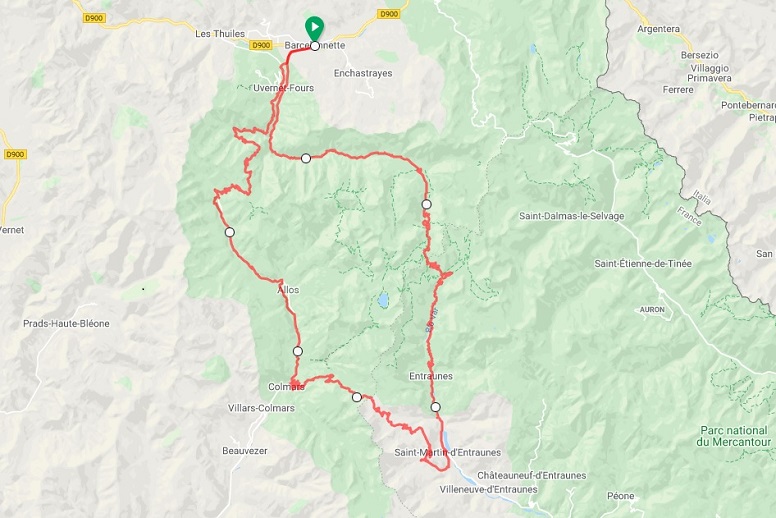
Other articles in our growing series of European road cycling blogs that might be of interest include:
Cycling with 5 Time TDF Champion – Miguel Indurain
Cycling Europe’s Highest Asphalted Road
Cycling the French Pyrenees (coming soon – January 2021)
